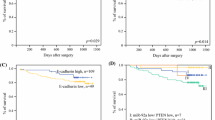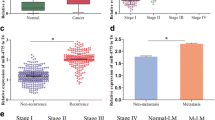Abstract
Human microRNA-9 (miR-9) has been reported to be involved in the metastasis of several malignancies including brain breast cancer. However, its role in the metastasis of colorectal cancer (CRC) remains to be revealed. Here, we evaluated miR-9 expression in metastatic CRC and investigated its effects on the motility and proliferation of RKO cells. The expressions of miR-9 in 15 primary CRC specimens without distant metastasis (NM group) and 10 primary CRC specimens (M group) with distant metastasis (M group) were determined by quantitative real-time PCR. The alternations in the motility and morphology of RKO cells before and after miR-9 transfection were analyzed by migration assay and F-actin staining. The relationship between miR-9 and α-catenin was identified by Western blotting. Cell growth was examined by MTT (3-[4,5-dimethylthiazol-2-yl]-2,5-diphenyl-tetrazoliumbromide) assay. Significant difference of miR-9 expression was observed in M group compared to the NM group (P < 0.001). Ectopic expression of miR-9 enhanced the motility of RKO cells as well as changed their morphological appearance, while cell growth remained unchanged. The overexpression of miR-9 could also down-regulate α-catenin expression. These data suggest that miR-9 may potentially participate in the metastatic process of CRC though facilitating cell motility.




Similar content being viewed by others
References
Blumgart LH, Fong Y. Surgical options in the treatment of hepatic metastasis from colorectal cancer. Curr Probl Surg. 1995;32(5):333–421.
Newland RC, Dent OF, Chapuis PH, Bokey EL. Clinicopathologically diagnosed residual tumor after resection for colorectal cancer. A 20-year prospective study. Cancer. 1993;72(5):1536–42.
Zhang H, Li Y, Lai M. The microRNA network and tumor metastasis. Oncogene. 2010;29(7):937–48.
Ma L, Young J, Prabhala H, Pan E, Mestdagh P, et al. miR-9, a MYC/MYCN-activated microRNA, regulates E-cadherin and cancer metastasis. Nat Cell Biol. 2010;12(3):247–56.
Nass D, Rosenwald S, Meiri E, Gilad S, Tabibian-Keissar H, et al. MiR-92b and miR-9/9* are specifically expressed in brain primary tumors and can be used to differentiate primary from metastatic brain tumors. Brain Pathol. 2009;19(3):375–83.
Zheng J, Xue H, Wang T, Jiang Y, Liu B, et al. miR-21 downregulates the tumor suppressor P12(CDK2AP1) and stimulates cell proliferation and invasion. J Cell Biochem. 2011;112(3):872–80.
Roybal JD, Zang Y, Ahn YH, Yang Y, Gibbons DL, et al. miR-200 Inhibits lung adenocarcinoma cell invasion and metastasis by targeting Flt1/VEGFR1. Mol Cancer Res. 2011;9(1):25–35.
Fowler A, Thomson D, Giles K, Maleki S, Mreich E, et al. miR-124a is frequently down-regulated in glioblastoma and is involved in migration and invasion. Eur J Cancer. 2011;47(6):953–63.
Wu ZS, Wu Q, Wang CQ, Wang XN, Huang J, et al. miR-340 inhibition of breast cancer cell migration and invasion through targeting of oncoprotein c-Met. Cancer. 2011 [Epub ahead of print].
Li X, Zhang Y, Shi Y, Dong G, Liang J, et al. MicroRNA-107, an oncogene MicroRNA that regulates tumor invasion and metastasis by targeting DICER1 in gastric cancer: MiR-107 promotes gastric cancer invasion and metastasis. J Cell Mol Med. 2011 [Epub ahead of print].
Hurteau GJ, Carlson JA, Spivack SD, Brock GJ. Overexpression of the microRNA hsa-miR-200c leads to reduced expression of transcription factor 8 and increased expression of E-cadherin. Cancer Res. 2007;67(17):7972–6.
Christoffersen NR, Silahtaroglu A, Orom UA, Kauppinen S, Lund AH. miR-200b mediates post-transcriptional repression of ZFHX1B. RNA. 2007;13(8):1172–8.
Kong W, Yang H, He L, Zhao JJ, Coppola D, et al. MicroRNA-155 is regulated by the transforming growth factor beta/Smad pathway and contributes to epithelial cell plasticity by targeting RhoA. Mol Cell Biol. 2008;28(22):6773–84.
Valastyan S, Reinhardt F, Benaich N, Calogrias D, Szasz AM, et al. A pleiotropically acting microRNA, miR-31, inhibits breast cancer metastasis. Cell. 2009;137(6):1032–46.
Ma L, Teruya-Feldstein J, Weinberg RA. Tumour invasion and metastasis initiated by microRNA-10b in breast cancer. Nature. 2007;449(7163):682–8.
Packer AN, Xing Y, Harper SQ, Jones L, Davidson BL. The bifunctional microRNA miR-9/miR-9* regulates REST and CoREST and is downregulated in Huntington’s disease. J Neurosci. 2008;28(53):14341–6.
Laneve P, Gioia U, Andriotto A, Moretti F, Bozzoni I, et al. A minicircuitry involving REST and CREB controls miR-9-2 expression during human neuronal differentiation. Nucleic Acids Res. 2010;38(20):6895–905.
Nusse R. Wnt signaling in disease and in development. Cell Res. 2005;15(1):28–32.
Breen E, Steele G Jr, Mercurio AM. Role of the E-cadherin/alpha-catenin complex in modulating cell–cell and cell–matrix adhesive properties of invasive colon carcinoma cells. Ann Surg Oncol. 1995;2(5):378–85.
Aberle H, Butz S, Stappert J, Weissig H, Kemler R, et al. Assembly of the cadherin-catenin complex in vitro with recombinant proteins. J Cell Sci. 1994;107(Pt 12):3655–63.
Rimm DL, Koslov ER, Kebriaei P, Cianci CD, Morrow JS. Alpha 1(E)-catenin is an actin-binding and -bundling protein mediating the attachment of F-actin to the membrane adhesion complex. Proc Natl Acad Sci USA. 1995;92(19):8813–7.
Pappas DJ, Rimm DL. Direct interaction of the C-terminal domain of alpha-catenin and F-actin is necessary for stabilized cell-cell adhesion. Cell Commun Adhes. 2006;13(3):151–70.
Gofuku J, Shiozaki H, Tsujinaka T, Inoue M, Tamura S, et al. Expression of E-cadherin and alpha-catenin in patients with colorectal carcinoma. Correlation with cancer invasion and metastasis. Am J Clin Pathol. 1999;111(1):29–37.
Kitagawa T, Matsumoto K, Nagafuchi A, Tsukita S, Suzuki H. Co-expression of E-cadherin and alpha-catenin molecules in colorectal cancer. Surg Today. 1999;29(6):511–8.
Raftopoulos I, Davaris P, Karatzas G, Karayannacos P, Kouraklis G. Level of alpha-catenin expression in colorectal cancer correlates with invasiveness, metastatic potential, and survival. J Surg Oncol. 1998;68(2):92–9.
Drees F, Pokutta S, Yamada S, Nelson WJ, Weis WI. Alpha-catenin is a molecular switch that binds E-cadherin-beta-catenin and regulates actin-filament assembly. Cell. 2005;123(5):903–15.
Acknowledgements
We are grateful to Dr. Lun Zhou from the Second Affiliated Hospital of Zhejiang University helping with analysis of clinical data. We thank Dr. Hongchuan Jin and Dr. Ajibade, Adebusola Abosede for helpful comments on the manuscript. This work was supported by grants from the National Natural Science Foundation of China (No. 81000892) and Zhejiang Provincial Natural Science Foundation of China (No. Y2100073).
Author information
Authors and Affiliations
Corresponding authors
Additional information
Liang Zhu and Huarong Chen contributed equally to this work.
Rights and permissions
About this article
Cite this article
Zhu, L., Chen, H., Zhou, D. et al. MicroRNA-9 up-regulation is involved in colorectal cancer metastasis via promoting cell motility. Med Oncol 29, 1037–1043 (2012). https://doi.org/10.1007/s12032-011-9975-z
Received:
Accepted:
Published:
Issue Date:
DOI: https://doi.org/10.1007/s12032-011-9975-z




